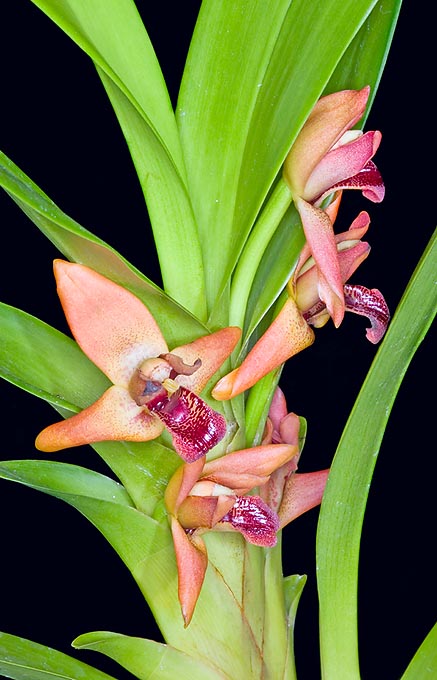Family : Orchidaceae

Text © Pietro Puccio

English translation by Mario Beltramini

Epiphytic and caespitose, Maxillariella elator is 1 m tall © Giuseppe Mazza
The name of the genus is the diminutive of Maxillaria, genus where it was previously inserted; the name of the species, “elatior” = higher, is the comparative of the Latin adjective “elatus”, with reference to the size of the plant.
The Maxillariella elatior (Rchb.f.) M.A.Blanco & Carnevali (2007) is a caespitose epiphytic species, up to even more than 1 m tall, with sturdy ramified rhizomes, up to about 40 cm of length and 1 cm of diameter, hanging or ascending, provided with distichous leaves with at the apex and laterally ovoid pseudobulbs, compressed, 4-9 cm long, 2-4 cm broad and 1 cm thick, with at the top 1-2 linear or lanceolate leaves of pale green colour, 10-40 cm long and 2-6 cm broad, coriaceous, similar to those placed along the rhizome.
Flowers of 4-5 cm of diameter, on an erect, 5-7 cm long peduncle from the axil of the foliar sheaths wrapping the pseudobulbs, solitary, fleshy, perfumed, with oblong sepals of 2-3 cm of length and 1-1,5 of breadth, of reddish yellow colour often spotted and striated of red, red petals close to the column, lanceolate with curved apices, 1,5-2,5 cm long and 0,5-1 cm broad, and ovate labellum with curved apex, about 2 cm long and 1 cm broad, of dark red colour.
It reproduces by seed, in vitro, and, easily, by division.
It is a vigorous species which forms, in short time, big tufts, with a long lasting flowering, 3-4 weeks, in autumn-winter. It requires a slightly shaded position, medium temperatures, with minimum night ones not under the 12-14 °C, a good ventilation and abundant and regular waterings during the vegetative period, more reduced in winter, but without allowing the substratum to dry up completely, paying particular attention that the water does not stagnate between the leaves of the emerging vegetation in order to avoid possible rottenness.
Waterings and nebulisations are to be done with rain water, or water obtained by reverse osmosis or demineralised, and the fertilizations, during the vegetative period, with hydro-soluble balanced products, with microelements, at ¼ of the dosage suggested on the package, distributed and alternated in way to avoid salts accumulations on the roots.
It can be mounted on bark or cork raft or cultivated in pot with medium sliced bark fragments and sphagnum; relocations, repottings and divisions are to be done at the time of the vegetative regrowth.
The species is inscribed into the appendix II of the CITES (species whose trade is internationally ruled).
Synonyms: Dicrypta elatior Rchb.f. (1845); Maxillaria triangularis Lindl. (1845); Maxillaria elatior (Rchb.f.) Rchb.f. (1863); Camaridium xylobiichilum Kraenzl. (1920); Maxillaria alberti Schltr. (1923); Pleuranthium albertii (Schltr.) Brieger (1977).
→ For general notions about ORCHIDACEAE please click here.
